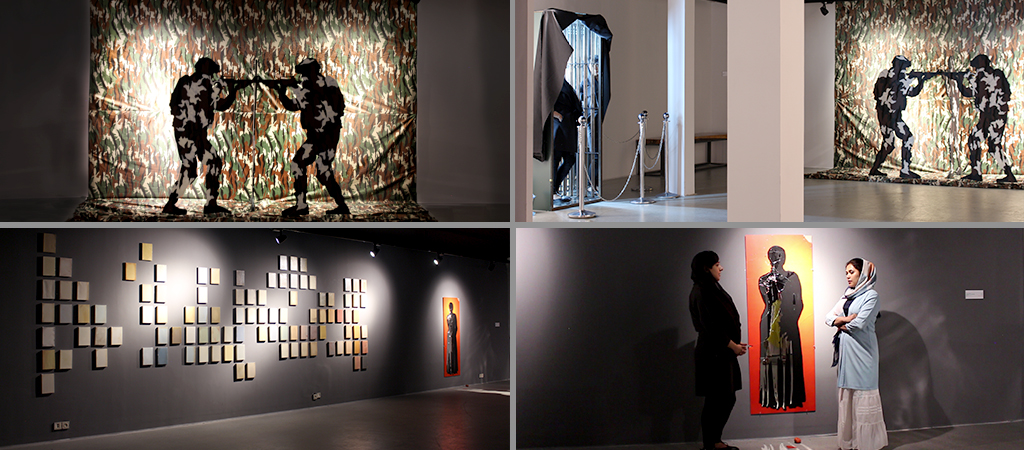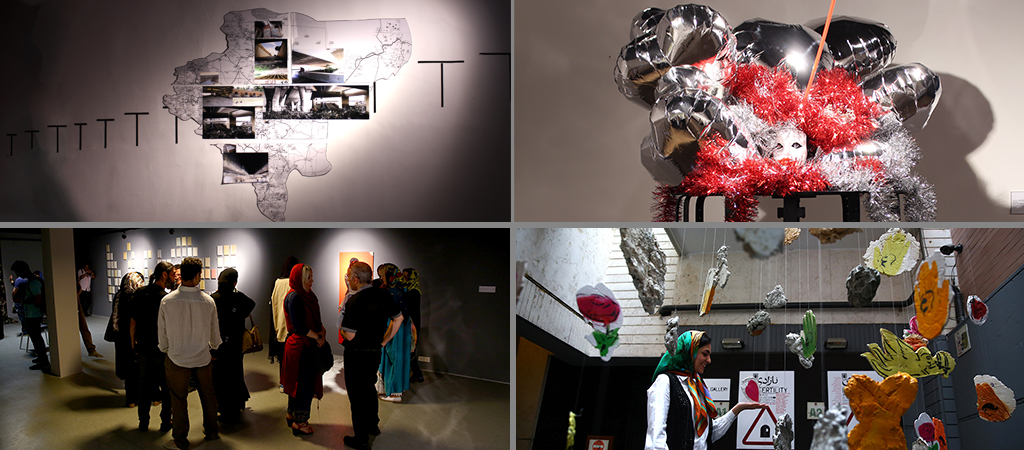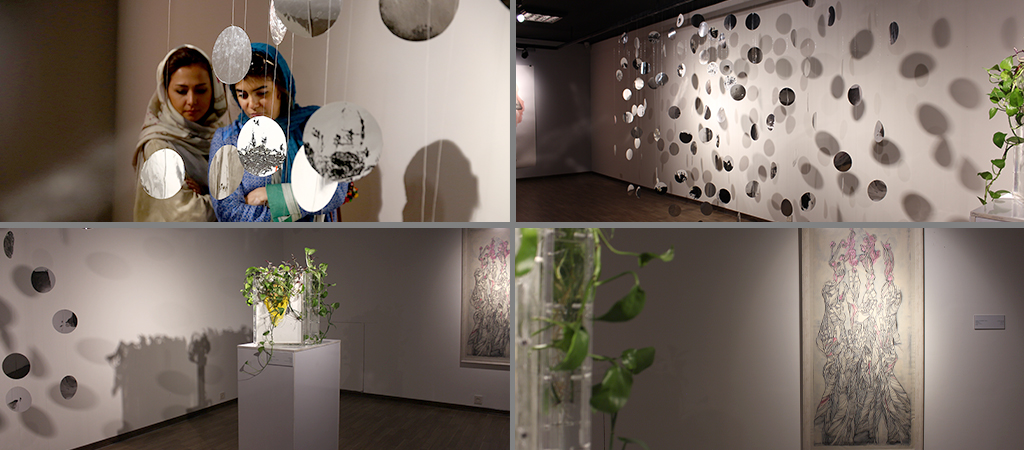


Infertility
Exhibition 22 June - 3 July 2018
A Gallery, Tehran, Iran
Curated by: Shahram Entekhabi and Asieh Salimian
Participating artists:
Negar Alemzadeh Gorji ; Basira Bolboli ; Mostafa Choobtarash ; Marjan Ghorbani ; Zahra Ghyasi ; Afsaneh Javadpour ; Zahra Mohamadi ; Pooneh Oshidari ; Nasim Pirhadi ; Zartosht Rahim ; Azam Tabatabaei ; Abolfazl Masoumi and Ehsan Ziafati
Infertility - نازادی
(scroll down for Farsi)
The conditions that actually lead to disinterest or indifference can be compared to the current state of the art scene in Iran. So far, the efforts of artists and art supporters have not been streamlined here, as the dispersal and lack of proper communication and the shortage of independent display spaces have caused them undeniable limitations. This is similar to the current situation in many countries in the region: The unpredictable conditions of future in the midst of social-political developments, along with international and regional change which has made planning and scheduling a difficult task to do, with an ambiguous outlook.
The realm of contemporary art in Iran has undergone many changes in the last two decades. These developments can be attributed to several international exhibitions about Iranian contemporary art in Europe in the early 2000's. The attention of international scene to contemporary art, introduced by Iranian artists inside and outside of Iran, influenced the artistic atmosphere of the country. The number of private galleries, the only active foundations of art, has unprecedentedly increased so far. The number of artists also increased the same. And today we see that in most metropolitan cities of Iran, similar activities have been developed by galleries, universities and artists. With the rise of manufacturers and consumers of contemporary art, the market flourished, which initially promised a glorious future. The benefits of this economic growth could not be sustained, as for the sake of meaningless investments, there was no sustainable system in which artistic production could be a sign of this economic growth. Contrived markets and auctions and other methods for increasing capital have succeeded less in investing as a sustainable growth. In the last decade, we see a shrinkage of this market that no longer had its international sales and distribution area and was slowly restricted to the Persian Gulf region and now has lost it. It goes without saying that the foundations of education did not have a positive effect on the underlying cultural growth of contemporary art, because educating and informing the students could not be successful in conveying the international developments in contemporary art to this generation clearly and transparently. The interpretation of what is going on in the world of art cannot be done without quoting the content and historical and social reasons only by referring to the earlier interpretations of art in Iran.
The exhibition "Infertility" introduces the works of fourteen young artists, with the aim of examining and questioning the issues of today's society in Iran. “Infertility” is another step from “Factory TT “ to exhibit works that cannot be displayed. Because the main function of the event is outside the framework dominating the realm of art that sale is the most important objective.
This exhibition is an attempt to establish a link between art and a society located in one of the most chaotic parts of the world. The art that is distant from revivalism tries to prove the necessity of its existence and relate its conditions to the society of its origin. Art can, beyond decorative or abstract aspects, have a great contribution to the culture of a nation, in order to meet the needs of the society, and less of the economic speculation of a small group.
Women's issues , standing on the brink of war, patriarchy and tradition, media incursion and advertising, lack of access to widespread information, signs and consequences of Western economic, political and cultural sanctions, violence, and perception of the ambiance of living conditions ...is one of the points that the exhibition deals with it. The works of the exhibition represent the life conditions in one of the largest cities in the world, as these problems are the outcome of dissatisfaction, economic and social pressures, environmental issues, and the confrontation between tradition and modernity.
Also, loneliness, discrimination, and conflict with personal limitations and gender identity in this breakdown are among the issues highlighted in the upstairs, and finishes with several works by young painters at the end of the gallery.
Shahram Entekhabi and Asieh Salimian, as the curators of the event, have tried to produce and select works in collaboration with most of these artists that include the main content and theme mentioned. It has been tried to create three different spaces by using light in the layout of each piece of work that are different in terms of static. The works of the exhibition have been produced in less than a month, with the advice and supervision of curators. Although the title for the exhibition is "Infertility", we encounter the opposite of it,"fertile", in the first work, and thereby the exhibition remains loyal to Factory TT's idea of "Conversion / production" to the last work.
بررسی زمینه های پیدایش آثار هنرمندان در حال ظهور ایرانی
کیوریتورها : شهرام انتخابی و آسیه سلیمیان
هنرمندان شرکت کننده: پونه اوشیدری ; بصیرا بلبلی ; نسیم پیرهادی ; افسانه جواد پور ; مصطفی چوب تراش ; زرتشت رحیمی ; احسان ضیافتی ; اعظم طباطبایی ; نگارعالم زاده گرجی ; مرجان قربانی ; ابوالفضل معصومی ; زهرا قیاسی ; زهرا محمدی
گالری آ, تهران, ایران
یکم تا دوازدهم تیر ماه ۱۳۹۷
شرایطی که عملا به مسخ یا بی تفاوتی منتهی می شود را می توان با وضعیت کنونی صحنه هنر معاصر در ایران مقایسه کرد. تا کنون تلاش های هنرمندان و پشتیبانان هنری در اینجا جریان ساز نشده است؛ چرا که پراکنده بودن و عدم ارتباطات مناسب و کمبود فضاهای مستقل نمایش، موجب محدودیت های غیر قابل انکاری برای آنان شده است. این مشابه با وضعیت کنونی بسیاری از کشورهای منطقه است: شرایط غیر قابل پیشبینی آینده در بحبوبه تحولات سیاسی اجتماعی، همراه با تغییرات بین المللی و منطقه ای. که برنامه ریزی و برنامه گذاری را به کاری دشوار همراه با چشم اندازی مبهم تبدیل کرده است.
صحنه ی هنر معاصر در ایران در دو دهه اخیر دچار تحولات بسیاری شد. این تحولات را می توان با چند نمایشگاه بین المللی در اوایل سالهای ۲۰۰۰ در اروپا از هنر معاصر ایران در ارتباط دانست. توجه صحنه ی بین المللی به هنر معاصر که در داخل و خارج از ایران به وسیله ی هنرمندان ایرانی معرفی شد، فضای هنری کشور را تحت تاثیر قرار داد. تعداد گالری های خصوصی که تنها بنیان های فعال معرف هنر بودند، از آن زمان به شکل بی سابقه ای رشد کرده است
تعداد هنرمندان نیز به همین صورت افزایش یافته. و امروز شاهد این هستیم که در اکثر کلان شهرهای ایران، فعالیت های مشابهی از گالری ها ، دانشگاه ها و هنرمندان توسعه یافته. با افزایش تولید کنندگان و مصرف کنندگان هنر معاصر، بازاری رونق گرفت که در ابتدا، آینده ی پر شکوهی را وعده می داد. منافع این رشد اقتصادی نتوانست پایدار بماند، چرا که به خاطر سرمایه گذاری بدون هدف، سیستم پایداری به وجود نیامد، که تولیدات هنری بتواند مبین این رشد اقتصادی باشد. بازارهای مصنوعی و حراج ها و دیگر کاربردهای افزایش سرمایه، کمتر در سرمایه گذاری به مثابه رشدِ پایدار موفق شدند. در ۱۰ سال اخیر، ما شاهد، کوچک شدن این بازار هستیم که دیگر منطقه ی ارائه و فروش خود را بین المللی نمی دید و آهسته آهسته خود را تا منطقه ی خلیج فارس عقب کشید و اکنون آن را هم از دست داده است. ناگفته نماند که بنیان های آموزشی هم نتوانستند در رشد فرهنگیِ زمینه ساز هنرهای معاصر تاثیر مثبتی داشته باشند، چرا که پرورش و اطلاع رسانی به دانشجویان نتوانست تحولات بین المللی هنر معاصر را به صورت واضح و شفاف به این نسل منتقل کند، تفسیر آنچه در جهان هنر می گذرد را نمی توان بدون نقل محتوا و دلایل تاریخی و اجتماعی تنها با اشاره به تعبیرهای پیشین از هنر در ایران انجام داد. نمایشگاه «نازادی» به معرفی آثار چهارده هنرمند جوان می پردازد، با هدف واکاوی و پرسشگری پیرامون مسائل جامعه ی امروز ایران. کارکرد اصلی این رویداد خارج از چارچوب حاکم بر عرصه ی هنر است که فروش حرف اول را در آن می زند
این نمایشگاه تلاشی است برای برقرای ارتباط میان هنر و جامعه ای که در یکی از بحرانی ترین نقاط دنیا جای دارد. هنری که از گذشته گرایی به دور است، می کوشد ضرورت وجود خود را اثبات کند و شرایط و بودنش را به جامعه ای که خاستگاهش بوده است ربط دهد. هنر می تواند فراسوی جنبه های تزئینی (دکوراتیو) یا انتزاعی، در فرهنگ سازی یک ملت سهم بزرگی داشته باشد تا از این رهگذر هم جوابگوی نیاز جامعه باشد و هم کمتر بازیچه و ابزار گمانه زنی اقتصادی یک گروه کوچک باشد
مشکلات زنان، ایستادن در آستانه ی جنگ، مردسالاری و سنت، هجوم رسانه ای و تبلیغات، عدم دسترسی به اطلاعات گسترده، نشانه ها و پیامدهای تحریم های اقتصادی، سیاسی و فرهنگی غرب، خشونت، و درک فضا با شرایط زندگی... از جمله نکاتی است که این نمایشگاه به آن می پردازد. آثار این نمایشگاه نمایانگر شرایط و مشکلات زندگی در یکی از بزرگترین شهرهای دنیاست، در حالی که این مشکلات پیامد نارضایتی، فشارهای اقتصادی و اجتماعی، معضلات زیست محیطی و برخورد سنت و مدرنیته است
همچنین تنهایی، تبعیض، و درگیری با محدودیت شخصی و هویت جنسیتی در این ازهم گسیختگی، از جمله مسائلی است که در طبقه ی بالا به آن پرداخته می شود و به همراه چند نقاشیِ نقاشان جوان در بخش انتهایی نمایشگاه به پایان می رسد. شهرام انتخابی و آسیه سلیمیان به عنوان کیوریتورهای این رویداد کوشیده اند در این نمایشگاه با همراهی اکثر هنرمندان کارهایی را تولید و انتخاب کنند که دربرگیرنده ی محتوا و تم اصلی ذکرشده باشد. در چیدمان تک تک آثار تلاش شده با استفاده از نور، سه فضای متفاوت پدید آید که از نظر ایستایی متفاوتند. آثار این نمایشگاه در مدت کمتر از یک ماه با مشورت و سرپرستی کیوریتورها تولید شده است. با آنکه اسم نمایشگاه «نازادی» است، اما در نخستین کار با مضمونی برعکس آن، یعنی «زایش» روبرو می شویم و بدین سان نمایشگاه تا آخرین کار به آرمان فکتوری تی تی ، یعنی «تبدیل/ تولید» وفادار می ماند
شهرام انتخابی و آسیه سلیمیان
تیرماه ۱۳۹۷